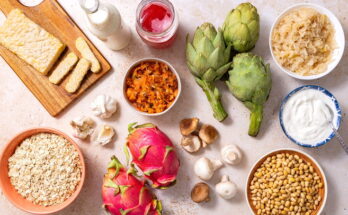Lotus Root Recipe: Lotus root is one of those underrated gems in the culinary world that often goes unnoticed, yet it’s packed with flavor, texture, and nutrition. If you’ve ever had a chance to try it, you’ll know it has a mild, slightly sweet, and nutty taste, combined with a satisfying crunch. Popular in Asian cuisines like Chinese, Japanese, Indian, and Korean, lotus root can be prepared in a variety of ways—stir-fried, braised, curried, or even deep-fried into crunchy chips.
So, what exactly makes lotus root special? Unlike regular vegetables, it has a beautiful lace-like pattern when sliced, which not only makes dishes look stunning but also gives them a unique bite. Many people love adding lotus root to soups and stews because it absorbs flavors beautifully while holding onto its crisp texture.
Besides taste, lotus root is a powerhouse of nutrients. It’s rich in dietary fiber, vitamin C, potassium, iron, and antioxidants, making it a healthy choice for those who want to enjoy a wholesome yet delicious meal. In fact, in traditional medicine, lotus root is considered beneficial for improving digestion, boosting immunity, and even calming the mind.
In this guide, we’re going to walk you through everything you need to know about cooking lotus root—from the ingredients you’ll need to a detailed step-by-step process. By the end, you’ll not only know how to prepare this beautiful vegetable but also how to elevate it into a flavorful dish that can easily impress anyone at your dining table.
Ingredients You’ll Need for Lotus Root Recipe
Before we jump into the cooking process, let’s take a closer look at the ingredients you’ll need. The beauty of lotus root is that it pairs well with both mild and bold flavors, so you can keep the recipe simple or make it extra rich and spicy depending on your taste preference.
Main Ingredients:
- Lotus Root (500g – fresh or frozen): The star of the dish. Fresh lotus root is ideal, but frozen or pre-sliced versions also work.
- Cooking Oil (2 tbsp): Vegetable oil, sesame oil, or even olive oil depending on the flavor you want.
- Garlic (2-3 cloves, minced): Adds a fragrant base.
- Onion (1 medium, finely chopped): For sweetness and depth.
- Salt (to taste): Enhances the flavor of lotus root.
- Turmeric Powder (½ tsp): Adds a beautiful golden color and health benefits.
- Chili Powder or Paprika (1 tsp): For a mild heat kick.
Optional Ingredients for Extra Flavor:
- Soy Sauce (1 tbsp): Adds umami and richness, especially in stir-fries.
- Green Chilies (1-2, sliced): For extra spiciness.
- Cilantro (a handful, chopped): For freshness and garnish.
- Cumin Seeds (½ tsp): Brings out earthy flavors.
- Lemon Juice (1 tbsp): Adds a refreshing tang at the end.
Substitutions and Variations:
- If you don’t have fresh lotus root, use frozen lotus root slices available in most Asian grocery stores.
- Replace soy sauce with tamari for a gluten-free option.
- Instead of frying, you can steam or boil lotus root for a lighter version.
- Swap spices based on your regional preferences—Indian recipes use turmeric, cumin, and coriander, while Chinese ones may rely more on soy, ginger, and sesame oil.
With these ingredients ready, you’re set to move on to the preparation process. Getting this part right is crucial because lotus root requires a little extra care before cooking to ensure the best taste and texture.
Preparing Lotus Root for Cooking
Cooking lotus root isn’t difficult, but preparation is key to making it taste and look good. Because it grows in mud, lotus root usually comes with dirt in its holes and skin, so it must be cleaned thoroughly before use.
Cleaning and Peeling the Lotus Root:
Start by rinsing the lotus root under cold water to wash off dirt. Use a vegetable peeler to remove the outer brown skin, revealing a smooth white surface. This step is important because the skin can be tough and slightly bitter.
Slicing Techniques for Different Recipes:
How you slice lotus root makes a big difference in the dish. Thin slices are perfect for stir-frying or frying into chips because they cook quickly and become crispy. Thicker slices are better for braising or curries as they hold their crunch even after simmering for a while. Some people even cut lotus root into long strips for unique textures.
Soaking and Preventing Discoloration:
After peeling and slicing, place lotus root pieces in a bowl of cold water with a few drops of vinegar or lemon juice. This prevents oxidation, which can turn the slices brown. It also helps remove excess starch, giving them a crispier bite when cooked.
By now, your lotus root should be perfectly prepped and ready to transform into a flavorful dish. Now, let’s dive into the cooking process itself.
Step-by-Step Guide to Making Lotus Root Recipe
Now comes the fun part—the actual cooking! This recipe is simple enough for beginners but can be elevated with spices and seasonings for experienced cooks who want more depth.
Step 1 – Preparing the Ingredients
Gather all the chopped onions, minced garlic, and spices beforehand. Having everything ready makes the cooking process smooth and hassle-free. Drain the lotus root slices from the water and pat them dry with a clean towel.
Step 2 – Cooking the Lotus Root
Heat oil in a pan over medium heat. Add cumin seeds (if using) and let them sizzle for a few seconds. Then, toss in garlic and onions, sautéing until golden brown. Add the lotus root slices and stir well.
Step 3 – Adding Spices and Flavors
Sprinkle turmeric, chili powder, and salt. Stir gently so each lotus root slice is coated with spices. For extra flavor, drizzle in soy sauce or add chopped green chilies.
Step 4 – Simmering to Perfection
Add about ½ cup of water, cover the pan, and let the lotus root cook for 10–15 minutes until tender yet crisp. Avoid overcooking, as lotus root should maintain its crunch.
Step 5 – Garnishing and Serving
Once cooked, turn off the heat and garnish with chopped cilantro and a splash of lemon juice. Serve hot with rice, flatbreads, or enjoy as a side dish.
This basic lotus root recipe can be customized endlessly, whether you want it spicy, savory, or slightly tangy.
Serving Suggestions and Pairings
A lotus root dish is versatile and goes well with a variety of meals. You can enjoy it as a light snack, a side dish, or even the centerpiece of your meal.
- Pair with steamed jasmine rice for a simple, wholesome meal.
- Serve alongside chapati, naan, or roti for an Indian-inspired version.
- For a Korean-style dish, pair with kimchi and grilled meats.
- Complement with light soups or broths to balance out the flavors.
Its crunchy yet tender texture makes it a delightful companion to almost any main dish.
Tips and Tricks for Perfect Lotus Root Recipe
Cooking lotus root may seem easy, but small mistakes can sometimes make the dish less enjoyable. To get that perfect balance of flavor, crunch, and tenderness, here are some pro tips and tricks you should keep in mind.
Common Mistakes to Avoid
One of the most common mistakes people make with lotus root is overcooking it. Lotus root is unique because it stays slightly crunchy even when cooked, but if you boil or fry it for too long, it can become mushy and lose its signature bite. Another mistake is not soaking it after slicing—if you skip this step, the lotus root can discolor and look unappetizing. Some beginners also add too much salt early on, forgetting that soy sauce or other seasonings may already contain salt, making the dish overly salty.
Enhancing the Flavor Profile
If you want your lotus root dish to stand out, don’t hesitate to experiment with spices and sauces. A sprinkle of sesame seeds adds nutty richness, while a drizzle of sesame oil gives a lovely aroma. For a bold kick, you can toss in ginger and chili flakes, or go with a sweet-savory balance by adding a touch of honey or hoisin sauce. The beauty of lotus root lies in its versatility—it absorbs flavors without losing its character.
Making the Recipe Healthier
For those who want a lighter version, you can reduce the amount of oil and instead stir-fry lotus root with a splash of vegetable broth. Another healthy tweak is steaming or baking instead of frying. If you’re looking for more nutrients, combine lotus root with other vegetables like carrots, bell peppers, or broccoli, making the dish more colorful and wholesome.
By keeping these tips in mind, you’ll not only master the art of cooking lotus root but also create variations that suit your personal taste and dietary needs.
Storing and Reheating Lotus Root Dish
Lotus root dishes can be made ahead of time and stored for later use, which makes them perfect for meal prep. However, since lotus root has a unique texture, storing and reheating it properly is important to keep it fresh and delicious.
Proper Storage Techniques
After cooking, allow the dish to cool completely before transferring it into an airtight container. Store it in the refrigerator to keep it fresh for 3–4 days. If you have leftover raw lotus root, peel and slice it, then soak it in water with a splash of vinegar or lemon juice to prevent browning. This can stay fresh in the fridge for about 2–3 days.
Best Ways to Reheat Without Losing Flavor
When reheating, avoid microwaving for too long, as this may make the lotus root soggy. The best way is to reheat it in a pan on medium heat, adding a splash of water or broth to restore moisture. This will bring back its crunch and keep the flavors intact.
How Long Can It Be Stored?
Cooked lotus root dishes last up to 4 days in the fridge. If you want to store it longer, you can freeze it, though freezing may slightly affect its crispness. Frozen lotus root dishes can last up to 2 months. To reheat, thaw overnight in the fridge and warm it on the stove before serving.
By following these storage and reheating methods, you’ll ensure your lotus root dish tastes just as good the next day.
Nutritional Value of Lotus Root Recipe
Lotus root is not just delicious—it’s incredibly nutritious too. It’s one of those vegetables that provide a perfect balance of vitamins, minerals, and fiber while being naturally low in calories.
Calorie Count and Macronutrients
A 100-gram serving of lotus root contains about 74 calories, making it a light yet filling ingredient. It has around 17 grams of carbohydrates, 2.6 grams of dietary fiber, and about 2 grams of protein. Since it’s naturally low in fat, it’s an excellent choice for those following a weight-conscious diet.
Vitamins and Minerals Present
Lotus root is particularly rich in vitamin C, which helps boost immunity and keeps your skin healthy. It also contains vitamin B6, which supports metabolism and brain health. The presence of potassium makes it great for maintaining healthy blood pressure, while iron and copper support blood circulation and energy levels.
Why It’s a Healthy Choice
Including lotus root in your diet means you’re not only enjoying a unique, tasty vegetable but also fueling your body with important nutrients. Its high fiber content promotes good digestion and prevents constipation, while its antioxidant properties protect against free radicals. For people managing diabetes, lotus root’s moderate glycemic index makes it a safe choice in balanced quantities.
All in all, lotus root is a wonderful vegetable that combines taste, beauty, and nutrition in every bite.
Variations of Lotus Root Recipes
One of the best things about lotus root is that it can be cooked in so many different ways. From crispy snacks to hearty curries, here are some popular variations you can try.
Spicy Lotus Root Stir Fry
This quick and easy stir fry is perfect for busy days. Thinly sliced lotus root is tossed with garlic, ginger, soy sauce, and chili for a fiery, crunchy dish. Pair it with steamed rice for a complete meal.
Lotus Root Curry
For a comforting Indian-style dish, lotus root is simmered in a tomato-onion gravy with spices like turmeric, cumin, coriander, and garam masala. This rich and flavorful curry pairs beautifully with chapati or rice.
Crispy Fried Lotus Root Chips
If you love snacks, this variation is for you. Thin lotus root slices are deep-fried or air-fried until golden brown and seasoned with salt, pepper, or paprika. These chips are crunchy, addictive, and a healthier alternative to regular potato chips.
These variations show just how versatile lotus root can be—whether you want something light, spicy, or indulgent, there’s a recipe for every craving.
FAQs about Lotus Root Recipe
1. Can I cook lotus root without peeling it?
Yes, you can, but peeling is recommended because the skin can be tough and slightly bitter.
2. How do I keep lotus root from turning brown?
Soak the slices in water with lemon juice or vinegar to prevent discoloration.
3. What does lotus root taste like?
It has a mild, slightly sweet, and nutty flavor with a crunchy texture, similar to water chestnuts.
4. Can I freeze cooked lotus root?
Yes, you can freeze it for up to 2 months, though the texture may become slightly softer when reheated.
5. Is lotus root safe for kids to eat?
Absolutely! It’s nutritious, easy to digest, and can be prepared in kid-friendly ways like chips or mild stir-fries.
Conclusion
Lotus root is truly a hidden gem in the kitchen. With its delicate crunch, mild flavor, and impressive nutritional profile, it deserves a place in every food lover’s recipe collection. From stir-fries to curries and crispy chips, this vegetable adapts beautifully to different cuisines and cooking methods. By following the step-by-step guide in this article, you can prepare a simple yet flavorful lotus root dish that’s sure to impress your family and friends.
So next time you’re at the market, pick up some lotus root and give this recipe a try—you’ll be surprised by how much you love it!



